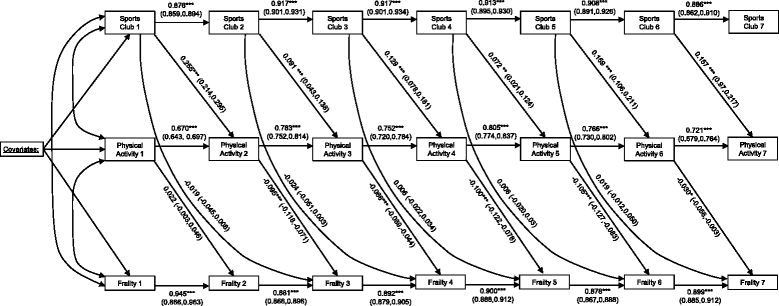The role of sports clubs in helping older people to stay active and prevent frailty: a longitudinal mediation analysis
- PMID: 28705220
- PMCID: PMC5512788
- DOI: 10.1186/s12966-017-0552-5
The role of sports clubs in helping older people to stay active and prevent frailty: a longitudinal mediation analysis
Abstract
Background: Frailty is a common syndrome in older adults characterised by increased vulnerability to adverse health outcomes as a result of decline in functional and physiological measures. Frailty predicts a range of poor health and social outcomes and is associated with increased risk of hospital admission. The health benefits of sport and physical activity and the health risks of inactivity are well known. However, less is known about the role of sports clubs and physical activity in preventing and managing frailty in older adults. The objective of this study is to examine the role of membership of sports clubs in promoting physical activity and reducing levels of frailty in older adults.
Methods: We used data from waves 1 to 7 of the English Longitudinal Study of Ageing (ELSA). Survey items on physical activity were combined to produce a measure of moderate or vigorous physical activity for each wave. Frailty was measured using an index of accumulated deficits. A total of sixty deficits, including symptoms, disabilities and diseases were recorded through self-report and tests. Direct and indirect relationships between sports club membership, levels of physical activity and frailty were examined using a cross-lagged panel model.
Results: We found evidence for an indirect relationship between sports club membership and frailty, mediated by physical activity. This finding was observed when examining time-specific indirect pathways and the total of all indirect pathways across seven waves of survey data (Est = -0.097 [95% CI = -0.124,-0.070], p = <0.001).
Conclusions: These analyses provide evidence to suggest that sports clubs may be useful in preventing and managing frailty in older adults, both directly and indirectly through increased physical activity levels. Sports clubs accessible to older people may improve health in this demographic by increasing activity levels and reducing frailty and associated comorbidities. There is a need for investment in these organisations to provide opportunities for older people to achieve the levels of physical activity necessary to prevent health problems associated with inactivity.
Keywords: Frailty; Older adults; Physical activity; Sports clubs.
Conflict of interest statement
Ethics approval and consent to participate
Ethical approval for all the ELSA waves was granted from the National Research and Ethics Committee. All participants provide written, informed consent to participate.
Consent for publication
Not applicable.
Competing interests
The authors declare that they have no competing interests.
Publisher’s Note
Springer Nature remains neutral with regard to jurisdictional claims in published maps and institutional affiliations.
Figures
Similar articles
-
Pathways from physical frailty to activity limitation in older people: Identifying moderators and mediators in the English Longitudinal Study of Ageing.Exp Gerontol. 2017 Nov;98:169-176. doi: 10.1016/j.exger.2017.08.029. Epub 2017 Aug 26. Exp Gerontol. 2017. PMID: 28844857
-
[Recent trends and challenges for older adults at community sport clubs in Japan: Analysis of FY 2016 Survey Results on Comprehensive Community Sports Clubs].Nihon Koshu Eisei Zasshi. 2020;67(5):311-318. doi: 10.11236/jph.67.5_311. Nihon Koshu Eisei Zasshi. 2020. PMID: 32493890 Japanese.
-
Social participation and physical prefrailty in older Japanese adults: The Shimane CoHRE study.PLoS One. 2020 Dec 16;15(12):e0243548. doi: 10.1371/journal.pone.0243548. eCollection 2020. PLoS One. 2020. PMID: 33326452 Free PMC article.
-
Physical Exercise for Frailty and Cardiovascular Diseases.Adv Exp Med Biol. 2020;1216:115-129. doi: 10.1007/978-3-030-33330-0_12. Adv Exp Med Biol. 2020. PMID: 31894552 Review.
-
American College of Sports Medicine Position Stand. Exercise and physical activity for older adults.Med Sci Sports Exerc. 1998 Jun;30(6):992-1008. Med Sci Sports Exerc. 1998. PMID: 9624662 Review.
Cited by
-
Comparative analysis of reported physical activity from leisure centres' members versus the general population in Spain.BMJ Open. 2021 Jun 29;11(6):e043963. doi: 10.1136/bmjopen-2020-043963. BMJ Open. 2021. PMID: 34187813 Free PMC article.
-
Using women-only fitness club and functional disability: a cross-sectional study using propensity score matching.Arch Public Health. 2025 Apr 25;83(1):114. doi: 10.1186/s13690-025-01601-8. Arch Public Health. 2025. PMID: 40281616 Free PMC article.
-
Are Gyms a Feasible Setting for Exercise Training Interventions in Patients with Cardiovascular Risk Factors? An Italian 10-Years Cross-Sectional Survey Comparison.Int J Environ Res Public Health. 2022 Feb 19;19(4):2407. doi: 10.3390/ijerph19042407. Int J Environ Res Public Health. 2022. PMID: 35206596 Free PMC article.
-
Older adults' and service providers' experiences of a settings-based health promotion initiative in English football.Health Promot Int. 2023 Jun 1;38(3):daad027. doi: 10.1093/heapro/daad027. Health Promot Int. 2023. PMID: 37339012 Free PMC article.
-
Correlates and determinants of physical activity among older adults of lower versus higher socio-economic status: a systematic review and meta-analysis.Int J Behav Nutr Phys Act. 2025 Jun 23;22(1):83. doi: 10.1186/s12966-025-01775-y. Int J Behav Nutr Phys Act. 2025. PMID: 40545526 Free PMC article. Review.
References
MeSH terms
LinkOut - more resources
Full Text Sources
Other Literature Sources
Medical
Research Materials


